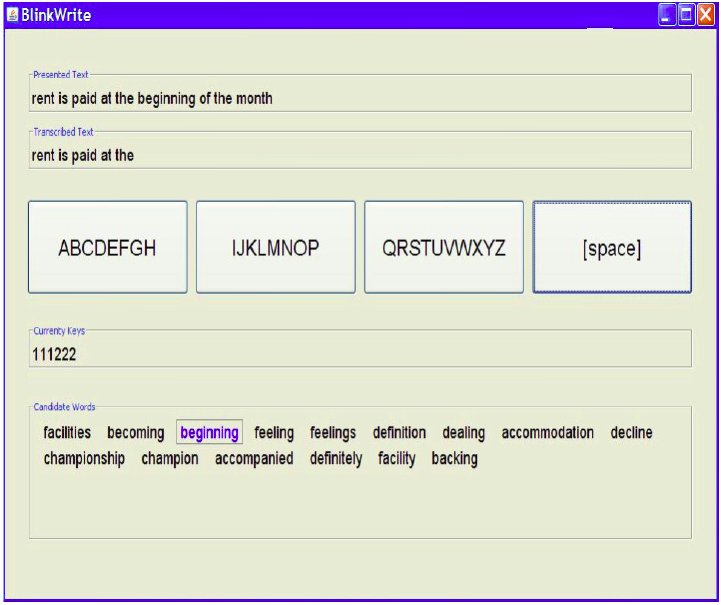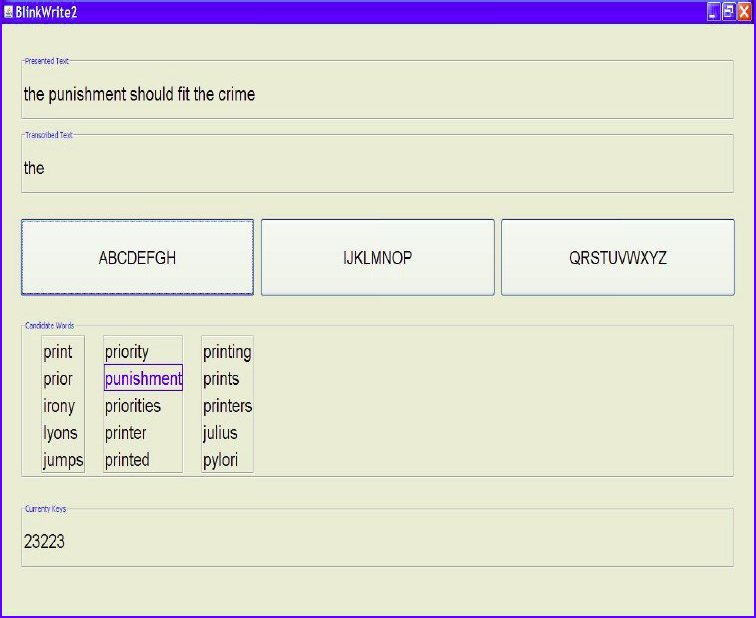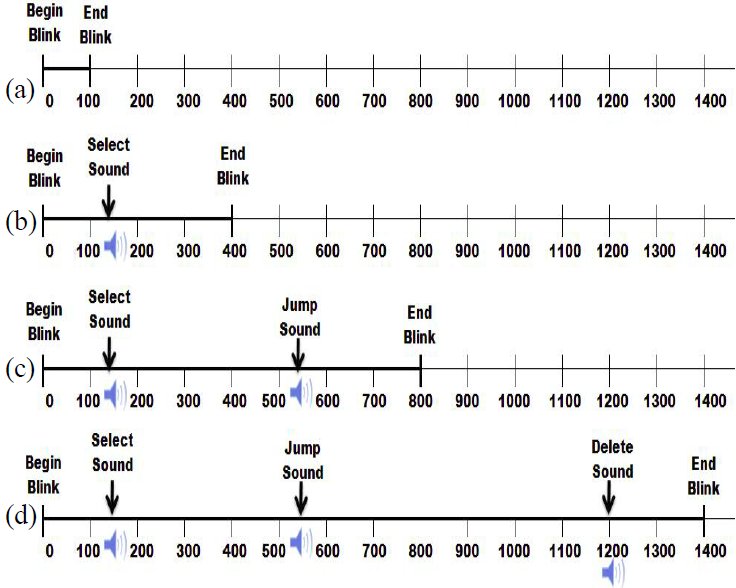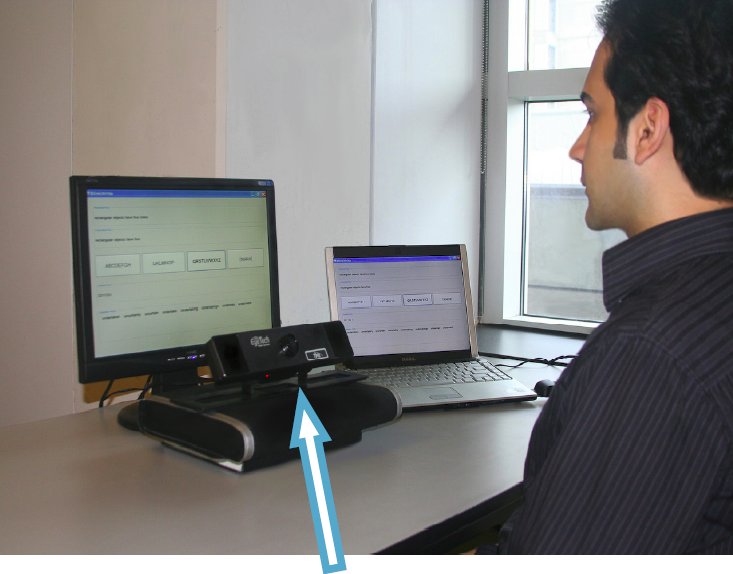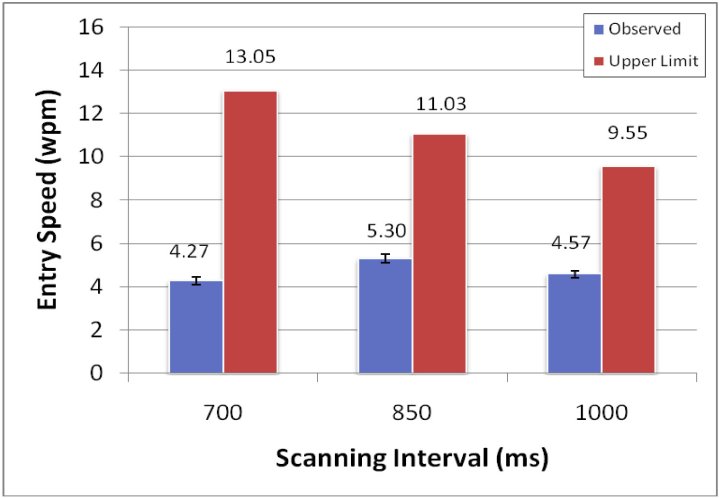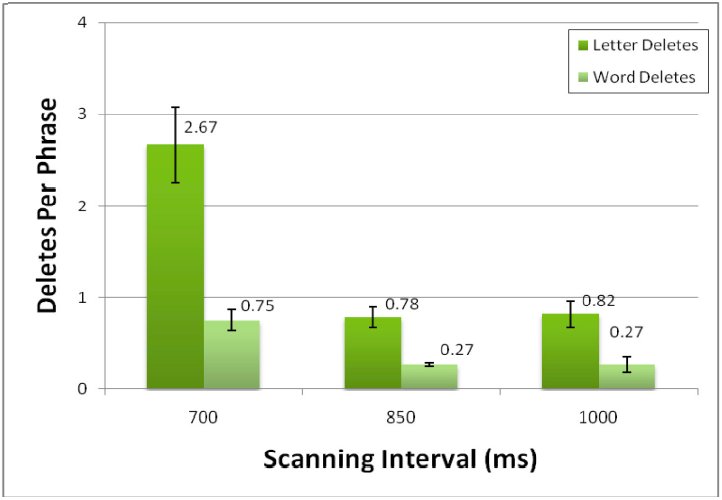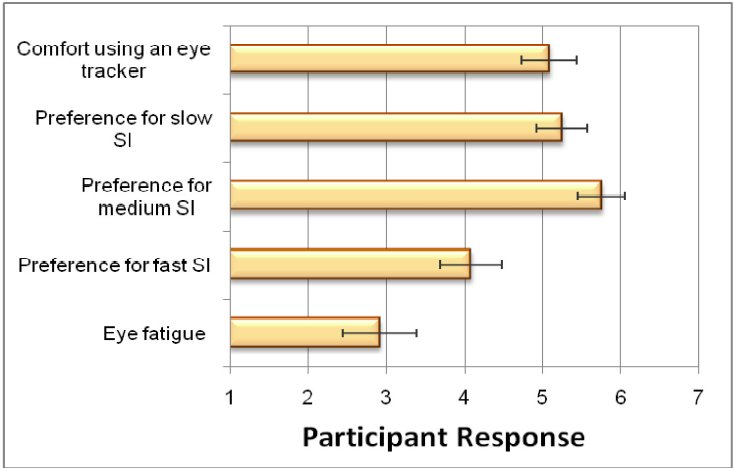Ashtiani, B., & MacKenzie, I. S. (2010). BlinkWrite2: An improved text entry method using eye blinks Proceedings of the ACM Symposium on Eye Tracking Research and Applications - ETRA 2010, 339-345. New York: ACM. [PDF]
BlinkWrite2:
An Improved Text Entry Method Using Eye Blinks
Behrooz Ashtiani & I. Scott MacKenzie
Dept. of Computer Science and EngineeringYork University Toronto, Canada M3J 1P3
{abehrooz,mack}@cse.yorku.ca
Abstract
Areas of design improvements for BlinkWrite, an eye blink text entry system, are examined, implemented, and evaluated. The result, BlinkWrite2, is a text entry system for individuals with severe motor impairment. Since the ability to blink is often preserved, even in severe conditions such as locked-in syndrome, BlinkWrite2 allows text entry and correction with blinks as the only input modality. Advantages of BlinkWrite2 over its predecessor include an increase in text entry speed. In a user evaluation, 12 participants achieved an average text entry rate of 5.3 wpm, representing a 16% increase over BlinkWrite and a 657% increase over the next fastest video-based eye blink text entry system reported in the literature.ACM Classification: K.4.2 [Computer and Society]: Social Issues – assistive technologies for persons with disabilities; H.5.2 [Information Interfaces and Presentation]: User Interfaces – input devices and strategies
Keywords: Blink typing, hands free text-entry, eye typing, scanning ambiguous keyboard, assistive technologies, locked-in syndrome, alternative communication, blink input, single input modality, blink detection
1 Introduction
Humans obtain considerable information through their eyes. For eye typing, the Internet and other digital and information technologies continue to enhance our experience as humans, providing new ways to communicate with friends, colleagues, and loved ones. These technologies have tremendous potential for disabled persons whose conditions hinder their ability to communicate and threaten isolation. Disabilities, such as amyotrophic lateral sclerosis (ALS), cerebral palsy (CB), or locked-in syndrome (LIS), are severe and often lead to complete loss of control over voluntary muscles, except the eye muscles, rendering the individual paralyzed and mute.
The eyes, therefore, become an important input modality to improve the quality of life of persons with a severe motor impairment by offering a window of communication to the outside world; a goal that is facilitated by enabling text entry using the eyes.
1.1 Eye Tracking and Eye Typing
Capturing eye biometrics is commonly performed using video cameras equipped with infrared or near-infrared light to produce corneal reflection. Video-based capturing techniques are more suitable for use in interactive systems than those based on Electro-OculoGraphy (EOG), scleral contact lens/search coil, Photo-OculoGraphy (POG) or Video-OculoGraphy (VOG) [Duchowski 2007; Gorodnichy 2004].
Most video-based eye tracking interfaces, when used for computer input, are designed to simulate a standard pointing device such as a mouse. A common application is text entry. So called "eye typing" allows the user to enter text by looking at keys on a soft keyboard (a.k.a. an on-screen keyboard or virtual keyboard) [Majaranta and Räihä 2002]. Keys are typically selected by holding the point of gaze (dwelling) on a key for a predetermined period of time, such as 750 ms.
While existing eye typing systems present a practical method of communication to some members of the disabled community, they fail to include the most severely motor impaired. Especially in the case of locked-in syndrome, movement of the eyes is limited and often unreliable for use with eye trackers [Laureys et al. 2005; Leon-Carrion et al. 2002]. As a result, eye typing systems are not a reliable alternative for persons with these disabilities, where blinking may be the only viable method of eye-based communication.
Fortunately, most eye tracking systems include an adjunct capability of detecting blinks, the rapid closing and opening of the eyelid. With regard to interface design, the challenge is to accommodate text entry using only a single binary input: blinking. In this paper, we describe BlinkWrite2, an eye blink text entry system.
1.2 Eye Blink Text Entry
The Diving Bell and the Butterfly is the memoir of Jean-Dominique Bauby, editor in chief of Elle magazine, who entered a state of locked-in syndrome in 1995 after suffering a massive stroke [Bauby 1998]. Under complete physical paralysis, his only method of communication was through the blink of his left eye. Entering text for the memoir involved a transcriber reciting a frequency-ordered alphabet, until he chose a letter by blinking. The entire book took some 200,000 blinks to compose using this method. 1 A typical word took two minutes to write (i.e., text entry speed = 0.5 wpm). Not only is this prohibitively slow, text composition required two people.
To our knowledge, there are only two examples in the literature of text entry using blinks as the sole input modality; i.e., video-based system without tracking eye movement.
Su et al. [2008] describe an eye blink-based communication aid for severely disabled individuals. Their proposed system consists of task-based menu selection of several daily necessities such as issuing voiced messages, typing, home appliance control, web surfing, etc. Row-column scanning was used to increase the rate of item selection, as with other single-switch input methods [Baljko and Tam 2006; Lesher et al. 1998; Venkatagiri 1999]. Upon selection of a task, related options or sub-tasks were displayed on the screen. For the typing task, a scanning keyboard with three-level selection (a.k.a. block, group, or quadrant scanning [Bhattacharya et al. 2008; Lin et al. 2007]) and scanning intervals of two seconds was evaluated. Participants were asked to type a set phrase "ci lab" with their blinks. A text entry rate of 0.6 words per minute (wpm)2 was reported.
BlinkWriter [Krolak and Strumillo 2008] replaces the popular automated scanning method for selection-traversal with a blink-pattern-based one. Voluntary blinks (duration > 200 ms) are classified as long blinks and are used for advancing to the next row and column. A row or column selection occurs if a new blink is not detected in two seconds. Therefore, typing a letter involves blinking to reach the desired row, delaying for selection, blinking to reach the desired column, and a final delay for letter selection. Letters are arranged based on frequency of occurrence in Polish. An average entry time of 10.7 seconds per character, or 0.7 wpm2 was reported. Importantly, these systems do not provide an integrated text correction mechanism (i.e., without selection of such a function in a menu outside of the keyboard itself).
In the absence of speech, interactive conversation is tolerable only if it achieves an minimum rate of 3 wpm [Darragh and Witten 1992]. BlinkWrite [MacKenzie and Ashtiani 2009], the first prototype, met the minimum requirements by reaching novice entry speeds of 4.8 wpm. BlinkWrite2 was developed to improve that speed. In the following section, we provide a brief description of the operation of BlinkWrite. This is followed with a description and evaluation of the improvements leading to BlinkWrite2.
2 BlinkWrite
BlinkWrite is a one-key text entry method using a scanning ambiguous keyboard (SAK). It combines the most demanding requirement of a scanning keyboard (one switch input) with the most appealing feature of an ambiguous keyboard (one keypress per character).
However, instead of using a physical key, BlinkWrite uses blinks to select virtual keys that are scanned, or highlighted in sequence. The interface is shown in Figure 1.
Figure 1. BlinkWrite experimental interface
BlinkWrite includes two regions, a letter-selection region and a word-selection region. The letter selection region includes four virtual keys. The 26 letters of the English alphabet are distributed across three keys. The fourth key is a [space] key. The keys are scanned cyclically with letters selected by blinking when the desired key is highlighted. With each selection, a word list is built from the current key sequence and is presented in the word-selection region. Scanning switches to the word-selection region when the user selects the [space] key. This is done after selecting all letter keys in a word, or sooner if the desired word appears early. Because the letter keys are ambiguous (as with a mobile phone keypad), there may be multiple words matching the selected keys, even if the full word is entered. However, as long as the word is in the system's dictionary, it is guaranteed to be present in the word-selection region.
A key aspect of the design of BlinkWrite was choosing the optimal number of letter keys and the letter assignment across keys. "Optimal" was defined as a design that minimizes the average number of scan steps per character (SPC) required to enter text in English. In searching for an optimal design, we used a frequency-ordered list of the 9,025 most-common words in English, as used in previous text entry research [Silfverberg et al. 2000]. The design in Figure 1 has SPC = 1.713.
3 BlinkWrite2
BlinkWrite was developed as an extension of a scanning ambiguous keyboard, inheriting its design principles and augmenting it with duration-based blink selection, error correction, and auditory feedback. BlinkWrite2 is a modified and improved version of BlinkWrite; these modifications involve changes to the layout and operation of BlinkWrite. In this section, we summarize the operation of BlinkWrite2, noting areas of improvement over the earlier version.
3.1 Implementation
BlinkWrite2 captures eye blinks using a TM3 eye tracker from EyeTech Digital Systems (http://www.eyetechds.com/). The device is bundled with QuickGlance software that acts as a high level hardware driver and provides general control over eye tracking, data capture, system setup, and calibration. An additional API, QuickLink, allows further customization of the interface and direct access to raw image data. In BlinkWrite, a background application called TrackerSetup was developed which modified control variables of QuickGlance to enable blink clicking and to disable eye movement tracking. However, TrackerSetup relied on QuickGlance for blink detection, auditory feedback, and interval durations.
QuickGlance provides a large set of features, designed for general purpose eye tracking; these features, while sufficient for development of BlinkWrite, impose limitations for BlinkWrite2 implementation. For instance, BlinkWrite2 needs three action intervals while QuickGlance only supports two action intervals to satisfy its general task of simulating left and right mouse buttons.
In BlinkWrite2, TrackerSetup was replaced by BlinkCapture, an application we developed to gain direct access to the image data of the eyes. This approach permitted great flexibility and allowed code to be written for blink detection, interval calculations, and auditory feedback. BlinkCapture continually surveys the image data of the eyes and reports their visibility. Upon detection of a blink (i.e., both eyes are closed), a timer starts to record its duration, stopping when at least one eye is opened.
3.1.1 Blinkwrite2 Prototype Software
In designing BlinkWrite2 to be faster and more efficient, the model of BlinkWrite was reviewed to find areas of possible improvement. It became evident that a reduction of SPC improves the upper limit text entry speed of the system (discussed in detail in section 3.1.6). This reduction was studied and applied to both regions of the system: letter-selection and word-selection.
Within the letter selection region, the [space] key was used as a method of ending letter-selection and moving to the word-selection region. However, since the system had to scan over this key in every cycle, it resulted in unnecessary overhead. Another disadvantage of the [space] key was the extra scans to reach it after the letter selection was finished. For instance for a word ending in letters "a" to "h", it took an extra three scans to reach the [space] key and proceed to the word-selection region. Further, running all the words in our dictionary through an algorithm and assuming early word selection opportunities are always taken, 26% of words end on the first key, 28% on second key, and the remaining 46% on the third key.
With these considerations, we introduced a new command, referred to as "jump", to jump to the word-selection region as soon as the word needs to be chosen. To access this command, a new blink interval is implemented in the system.
Words in the word-selection region were ordered based on frequency of occurrence. Word selection suffered mainly from the linear scanning of the list. The word-selection region was redesigned to support column-row scanning of the words to reduce the scans required to reach the desired word; effectively, this reduces the overall SPC of the system. However, column-row scanning also reduces the overall text entry speed by increasing the selections per scan step (SPS), since extra selections are required to select appropriate rows. The resulting layout for BlinkWrite2 is shown in Figure 2.
Figure 2. BlinkWrite2's graphical user interface
3.1.2 Blinking Intervals
In BlinkWrite2, blinks are classified into four intervals based on duration. To accommodate the new "jump" command, a new interval is added to the three existing intervals of BlinkWrite and all lower and upper bounds are adjusted.
Blinks of less than 140 ms are ignored as they are attributed to involuntary blinks and occasional false positives in blink detection. This threshold is based on a pilot study to find a reasonable threshold, separating voluntary and involuntary blinks without sacrificing responsiveness of the system. BlinkWrite used a 200 ms threshold in accordance with previous research [Grauman et al. 2003; Jacob 1990]; however, during the pilot study this value was found to be too conservative and often ignored voluntary blinks, causing frustration.
Values chosen for lower and upper bounds of other intervals are also based on the results of the pilot study and reflect the intervals considered most comfortable for issuing commands using blinks. These blinks are named based on their assigned action in BlinkWrite2. Blinks of durations between 140 ms and 540 ms are classified as "selection blinks". Blink of 540 ms to 1200 ms are "jump blinks". Blinks longer than 1200 ms are "deletion blinks".
The decision to assign the deletion operation to the last interval (blink duration > 1200 ms) is based on results of BlinkWrite prototype which reported an average of 2.2 corrections per phrase. Since a jump command is issued at least five times per phrase (at the end of typing each word), it is reasonable to assign it a lower interval to optimize overall speed of the system.
3.1.3 Context Sensitive Commands
Since the commands are assigned to time intervals, they directly affect the performance of the system. As a result, ensuring their usefulness across the two regions of the interface is important. Further, design decisions must keep the commands simple, intuitive, and consistent. For instance, the jump operation is used more frequently than delete in the letter-selection region; upon discovering that delete is more prevalent in the word-selection region, it is logical to design the system so that delete is assigned a shorter interval (replace jump's assigned interval) once scanning moves to the word selection region. This dynamic assignment of commands to intervals is confusing and unintuitive to the users who are already cognitively involved in a timed selection task. With these considerations, we designed the commands to always remain in their respective intervals but act according to what is intuitively expected. A summary of actions and context is provided in Table 1.
| Context/Action | Select | Jump | Delete |
| During letter selection | Select a letter | Jump to word list | Delete a letter/word |
| During word list column selection | Select a column | Jump to first column | Delete last letter |
| During word selection | Select a word | Jump to previous column | Delete last letter |
The select command is used consistently for selection. The new jump command allows jumping to the word list once letter selection is finished. While the columns in the word-selection region are scanned, a jump command causes a jump to the first column allowing a missed opportunity for column selection to be corrected.
Similarly if a column selection was intended but missed, resulting in the next column being selected, issuing a jump provides a chance for correction by jumping to the previous column.
Deleting during letter selection will delete the last letter or the last word using the method discussed in the next section. Attempting a delete in the word-selection region means either the word is mistyped or a jump was issued too early; therefore, the last typed letter is deleted and scanning returns to the letter selection region.
3.1.4 Error Correction
The delete operation remains the same as in BlinkWrite. Both single-letter delete and word delete are supported. The deletion algorithm includes a mechanism to avoid lengthy and frustrating sequences of single-letter deletes. Briefly, a delete operation removes either the last keystroke (letter) if input is in the middle of a word, or the last word if input is between words. If a single-letter delete is followed immediately by another delete, the effect is to remove the rest of the keystrokes for the current word. The next delete operation would remove the preceding word, and so on.
3.1.5 Auditory Feedback
In the absence of feedback, users of eye tracking systems are left guessing whether the system captured their intended input correctly. Since input with BlinkWrite2 involves keeping the eyes closed for a period of time, visual feedback can be missed. Another problem arises when system commands are performed based on the duration of blinks. It is difficult for users to adapt to and learn the timing by practice. Auditory feedback is used in BlinkWrite2 in a manner that informs and attunes users of the exact time an operation is committed.
BlinkWrite supported only selection and deletion. With the added complexities of a third action (i.e., jump), it is more important to utilize sounds that are intuitive (e.g., sound of recycle bin in the Microsoft Windows XP) and are as distinct as possible. Since the sounds play at the beginning of each interval, sounds of each preceding interval are played before the sound of current interval. See Figure 3. It is therefore important for the duration of the sounds to be short to avoid overlap.
Figure 3. Auditory feedback and blink durations. (a) involuntary blink <140 ms (no feedback) (b) select blink of duration 400 ms with auditory feedback at 140 ms (c) jump blink of duration 800 ms with auditory feedback at 140 ms and 540 ms (d) delete blink of duration 1400 ms with auditory feedback at 140 ms, 540 ms, and 1200 ms
Several sets of sounds were created and subjected to a pilot study. One set was chosen for BlinkWrite2. The "select" sound (duration = 30 ms) is softer than a regular mouse click. Jump and delete sounds (durations = 200 ms) were designed to contrast each other (e.g., sounds of insertion and removal of USB devices in Microsoft Windows XP). The timing of the auditory feedback with respect to the blink dynamics is illustrated in Figure 3. For completeness, an involuntary blink of <140 ms duration is included in the figure (Figure 3a).
Auditory stimuli are generated at the beginning of intervals of all commands. For a selection attempt, the feedback is generated at 140 ms. See Figure 3b. Figure 3c and Figure 3d provide examples of jump and delete blinks respectively; note how in addition to the feedback related to their intervals, the feedback from previous intervals is also generated. This effect is required since the action intended by the blink is not known until the blink has ended.
The results of BlinkWrite experiments suggested that this poses no problem for the user. In fact, the consistency of having distinct auditory signals at the 140 ms, 540 ms, and 1200 ms points helps users accurately learn and perform the available action commands.
3.1.6 Upper Limit Text Entry Speed.
The timing interval inherent with scanning keyboards places a strict upper limit on entry speed – a limit that is governed by the design of the keyboard, rather than a person's proficiency in using it. For blink-based systems using a scanning ambiguous keyboard, as described here, the upper limit is given by:

| (1) |
where
- S = upper limit for text entry speed in wpm
- SI = scanning interval in milliseconds
- SPC = number of scan steps per character
- SPS = number of selections per scan step
- BT = minimum blink time for selection in milliseconds
BlinkWrite had SPC = 1.713, SPS = 0.627, and BT = 200 ms. Assuming SI = 700, BlinkWrite's upper text entry speed was 8.5 wpm. BlinkWrite2's design modifications and interval adjustments resulted in SPC = 1.122, SPS = 0.856, and BT = 140 ms. Therefore, SPC is reduced by 35%, while a negative side effect of 14% increase on SPS is incurred. The upper text entry speed of BlinkWrite2 is:

| (2) |
This shows that BlinkWrite2's upper limit text entry speed is 53% higher than that of BlinkWrite. While these values are promising, a user study is required to determine how the new system performs in practice.
4 Methodology
4.1 Participants
Twelve volunteer participants ranging in age from 22 years to 31 years (mean = 26, SD = 2.7) were recruited. Five were female, seven male. All were daily users of computers, reporting 4 to 10 hours of usage per day (mean = 7, SD = 3.4). Three used corrective lenses (2 females, 1 male). None had prior experience using BlinkWrite or BlinkWrite2.
4.2 Apparatus
The EyeTech Digital Systems TM3 eye tracker (described above) was connected to a standard Microsoft Windows XP notebook with a 2.0 GHz Intel Core2 duo CPU and 4 GB of memory. The BlinkWrite2 application was displayed on an external 15" LCD monitor. The eye tracker was raised on a book and a notebook case to achieve an optimal angle for eye detection. The setup is shown in Figure 4.
Figure 4. Experimental apparatus used for BlinkWrite2 evaluation. The EyeTech Digital Systems TM3 is identified by the block arrow.
4.3 Procedure
Prior to collecting data, the experimenter explained the task and demonstrated the software. Participants were instructed on the method of text entry, early word selection, error correction, and the audio feedback. They were instructed to enter the given phrases as quickly and accurately as possible and make corrections only if an error is detected in the current or previous word. Participants were asked to adjust the height of the chair and their distance from the display to positions deemed comfortable. The angle and distance of the eye tracker were adjusted accordingly, to achieve an optimal lock on their eyes, evident by a crosshair displayed inside the image of the eyes in QuickGlance software.
Participants were allowed to enter a few trial phrases to become familiar with the selection and correction methods and the corresponding audio feedback. For the experiment, data collection began with the first selection blink for each phrase and ended upon completion of that phrase. The phrases were chosen randomly from a standard set of 500 phrases for evaluating text entry systems [MacKenzie and Soukoreff 2003]. Phrase lengths ranged from 16 characters to 43 characters (mean = 28.6). A separate scan steps per character analysis was done of the phrase set. The result was SPC = 1.850, making the phrases, on average, more complicated than English in general. (BlinkWrite2 System has SPC = 1.121) Although, this might seem like a minor point, the phrases used in evaluating systems like BlinkWrite2 play a critical role. For example, it would be relatively easy to concoct phrases using words with low SPC values, and thereby obtain artificially inflated results. This was not done. If anything, using a phrase set with a higher SPC than English will yield results on the conservative side. Participants were allowed to rest at their discretion between phrases. The QuickGlance software was checked after each break to ensure proper blink detection; adjustments were applied if necessary. After completing the experiment, participants were given a questionnaire soliciting demographic information (results cited below) and their impressions of the most suitable scanning interval.
4.4 Design
The experiment included a single independent variable, scanning interval, with three levels: 700 ms, 850 ms, and 1000 ms. As we were interested in determining an optimal scanning interval for initial use of BlinkWrite2, counter-balancing was used in assigning the three levels to participants. To offset learning effects, two participants were assigned to each of the six possible orders for the three conditions. Values for the scanning interval were chosen based on results from the earlier BlinkWrite evaluation [MacKenzie and Ashtiani 2009]. For each scanning interval condition, participants entered five phrases of text, yielding a total of 12 participants × 3 scanning intervals × 5 phrases = 180 phrases of input.
5 Results and Discussion
5.1 Speed
The grand mean for entry speed was 4.71 wpm. This alone is a promising result, given that entry involves only eye blinks. Of the three scanning intervals tested, the nominal setting of 850 ms was fastest at 5.30 wpm. The other two scanning intervals were slightly slower: 4.57 wpm at 1000 ms and 4.27 wpm at 700 ms. See Figure 5.
Figure 5. Text entry speed by scanning interval. Error bars show ±1 SE. We consider this a promising result, particularly in view of the fact that each participant entered only five phrases for each scanning interval. No doubt, with continued practice entry speeds would increase toward the upper limit.
The effect of scanning interval on entry speed was statistically significant (F2,22 = 12.17, p < .0001). Figure 5 also includes the upper limit for text entry speed at each scanning interval. The values were calculated using Equation 1 with SPC = 1.122, SPS = 0.856, and BT = 140 ms. Although the upper limit increases with a decreasing scanning interval, participants were not able to demonstrate a corresponding increase in text entry speed.
It is noteworthy, however, that with a scanning interval of 850 ms, participants' text entry speed, at 5.30 wpm, was 48% of the upper limit speed of 11.03 wpm and 16% higher than the corresponding figure for BlinkWrite. The next fastest eye blink text entry system, BlinkWriter [Krolak and Strumillo 2008], reached the maximum speed of 0.7 wpm. BlinkWrite2 shows a 657% increase in text entry speed when compared to BlinkWriter.
5.2 Accuracy
The accuracy in participants' responses is revealed in two ways: (i) the errors in the transcribed text and (ii) the errors committed but corrected. The former were computed using the minimum string distance (MSD) method of comparing the presented text string with the transcribed text string [MacKenzie and Soukoreff 2002]. The error rates are quite low overall, as participants generally chose to correct errors during entry. In fact, 91.12% of all phrases had an error rate of 0%. Typically, if any errors were left in the transcribed text, it was because an incorrect word was selected early in the phrase or the participant simply didn't look for or notice the error. Consequently, those transcribed text phrases that contained errors, tended to have a large error rate (e.g., 10% - 20%).
Errors committed but corrected are reflected in the incidence of delete blinks (> 1200 ms) for letter delete or word delete. The results are shown in Figure 6. As with entry speed and error rates, the best performance occurred with a scanning interval of 850 ms, with 0.78 letter deletes and 0.27 word deletes per phase. (Recall that the mean phrase length was 28.6 characters, equivalent to 5.7 words.) Delete blinks were three times as prevalent with a scanning interval of 700 ms.
Figure 6. Letter and word deletions per phrase by scanning interval. Error bars show ±1 SD.
5.3 Optimal Scanning Interval
It seems the three levels chosen for the scanning intervals were appropriate in the sense that they bracketed user behaviour. Performance overall was best with a scanning interval of 850 ms: entry speed was fastest, error rate was lowest, and letter deletes and word deletes were lowest. Participants' performance suffered at the faster (700 ms) and slower (1000 ms) scanning intervals. Our observations reaffirm the nominal value of about 850 ms as being preferred for initial use of BlinkWrite2. Of course with practice, the situation would change. Simpson and Koester, for example, used an adaptive scanning interval [Simpson and Koester 1999]. As expertise developed, the scanning interval was incrementally reduced according to user performance. Optimal performance was achieved at 525 ms. With practice, users of BlinkWrite2 could, no doubt, work effectively with a faster scanning interval and thereby achieve higher text entry throughput. Of course the scanning interval with BlinkWrite2 is slightly different than with typical scanning keyboards. BlinkWrite2 selections occur through blinks of duration 140 ms to 540 ms. With each blink, the scanning timer is restarted, making the full duration of the scanning interval available again for a subsequent selection in the same scan if the next letter is on the same key. So, faster scanning intervals do not bring the same sense of "urgency" with BlinkWrite2 as they do with traditional scanning keyboards. Nevertheless, while faster scanning intervals increase text entry throughput with traditional scanning keyboards, the connection is less direct with BlinkWrite2.
5.4 Questionnaire
The questionnaire solicited participant responses on their level of comfort in using the eye tracker, their eye fatigue, and their preference for the scanning interval settings. Responses were rated on a 7-point Likert scale, where 1 is the least favorable response and 7 is the most favorable response. The results are shown in Figure 7.
Figure 7. Results of the questionnaire for comfort and preference. A response of 7 is most-favourable, and 1 least-favourable. Error bars = ±1 SE.
83% of participants rated the medium scanning interval of 850 ms higher than the other two settings. One of the most prevalent complaints in BlinkWrite was the fatigue caused by slow scanning of the candidate word list. Overall, 75% of the users of BlinkWrite reported a higher than average (average = score of 4) eye fatigue during the experiment. By introducing the column-row scanning method for word selection, and more accurate blink capture by developing BlinkCapture, only 16% of BlinkWrite2 users reported a higher than average eye fatigue; 67% of users felt comfortable using the eye tracker for interaction.
6 Conclusion
Improvements to the design of BlinkWrite and generic scanning ambiguous keyboards were proposed. Changes to the layout, interval and auditory feedback adjustments were implemented as a new prototype called BlinkWrite2. In a user study to determine the practical speed improvements, users achieved a mean text entry speed of 5.3 wpm. This represents a 16% increase over BlinkWrite, and a 657% increase over the next fastest eye blink text entry system reported in the literature. It is expected that BlinkWrite2 holds promise as a viable text entry method for users with severe motor disabilities who are otherwise precluded from using computing technology for communication.
7 References
BALJKO, M. and TAM, A. 2006. Indirect text entry using one or two keys. In Proceedings of the ACM SIGACCESS Conference on Assistive Technologies - ASSETS 2006, New York: ACM, 18 - 25. https://doi.org/10.1145/1168987.1168992
BAUBY, J. D., The diving bell and the butterfly. New York: Vintage International, 1998. https://thedisabilitybooks.org/pdf/the-diving-bell-and-the-butterfly.pdf
BHATTACHARYA, S., SAMANTA, D., and BASU, A. 2008. User errors on scanning keyboards: Empirical study, model and design principles, Interacting with Computers, 20, 406 - 418. https://doi.org/10.1016/j.intcom.2008.03.002
DARRAGH, J. J. and WITTEN, I. H., The reactive keyboard. Cambridge: Cambridge University Press, 1992. https://doi.org/10.1109/2.60879
DUCHOWSKI, A., Eye tracking methodology theory and practice (2nd edition), London: Springer, 2007. https://link.springer.com/book/10.1007/978-1-84628-609-4
GORODNICHY, D. O. 2004. Towards automatic retrieval of blink-based lexicon for persons suffered from brain-stem injury using video cameras. In Proceedings of the 2004 Conference on Computer Vision and Pattern Recognition Workshop - CVPRW 2004, New York: IEEE, 68 - 68. https://doi.org/10.1109/CVPR.2004.464
GRAUMAN, K., BETKE, M., LOMBARDI, J., GIPS, J., and BRADSKI, G. R. 2003. Communication via eye blinks and eyebrow raises: Video-based human-computer interfaces, Universal Access in the Information Society – UAIS 2003, 2, 359 - 373. https://doi.org/10.1007/s10209-003-0062-x
JACOB, R. J. K. 1990. What you look at is what you get: Eye movement-based interaction techniques. In Proceedings of the SIGCHI Conference on Human Factors in Computing Systems - CHI 1990, New York: ACM, 11 - 18. https://doi.org/10.1145/97243.97246
KROLAK, A., and STRUMILLO, P. 2008. Vision-based eye blink monitoring system for human-computer interfacing. In Conference on Human System Interactions – HIS 2008, New York: IEEE, 994 - 998. https://doi.org/10.1109/HSI.2008.4581580
LAUREYS, S., PELLAS, F., VAN EECKHOUT, P., GHORBEL, S., SCHNAKERS, C., PERRIN, F., BERRÉ, J., FAYMONVILLE, M. E., PANTKE, K. H., DAMAS, F., LAMY, M., MOONEN, G., and GOLDMAN, S. 2005. The locked-in syndrome: What is it like to be conscious but paralyzed and voiceless? Progress in Brain Research, 150, 495 - 511. https://doi.org/10.1016/S0079-6123(05)50034-7
LEON-CARRION, J., VAN EECKHOUT, P., DOMINGUEZ-MORALES, M. D., and PEREZ-SANTAMARIA, F. J. 2002. The locked-in syndrome: A syndrome looking for a therapy, Brain Injury, 16, 571 - 582. https://doi.org/10.1080/02699050110119466
LESHER, G., MOULTON, B., and HIGGINBOTHAM, J. 1998. Techniques for augmenting scanning communication, Augmentative and Alternative Communication, 14, 81 -101. https://doi.org/10.1080/07434619812331278236
LIN, Y.-L., CHEN, M.-C., WU, Y.-P., YEH, Y.-M., and WANG, H.-P., A flexible on-screen keyboard: Dynamically adapting for individuals' needs, in Universal Access in Human-Computer Interaction. Applications and Services, Berlin: Springer, 2007, 371 - 379. https://doi.org/10.1007/978-3-540-73283-9_42
MACKENZIE, I. S. and ASHTIANI, B. 2009. BlinkWrite: Efficient text entry using eye blinks, Universal Access in the Information Society (UAIS) (in press). https://doi.org/10.1007/s10209-010-0188-6
MACKENZIE, I. S. and SOUKOREFF, R. W. 2002. A character-level error analysis technique for evaluating text entry methods. In Proceedings of the Second Nordic Conference on Human-computer Interaction – NordiCHI 2002, New York: ACM, 243 - 246. https://doi.org/10.1145/572020.572056
MACKENZIE, I. S. and SOUKOREFF, R. W. 2003. Phrase sets for evaluating text entry techniques, in Extended Abstracts of the ACM Conference on Human Factors in Computing Systems - CHI 2003, New York: ACM, 754 - 755. https://doi.org/10.1145/765891.765971
MAJARANTA, P. and RÄIHÄ, K.-J. 2002. Twenty years of eye typing: Systems and design issues. In Proceedings of the ACM Symposium on Eye Tracking Research and Applications - ETRA 2002, New York: ACM, 15 - 22. https://doi.org/10.1145/507072.507076
SILFVERBERG, M., MACKENZIE, I. S., and KORHONEN, P. 2000. Predicting text entry speed on mobile phones. In Proceedings of the SIGCHI Conference on Human Factors in Computing Systems – CHI 2000, New York: ACM, 9 - 16. https://doi.org/10.1145/332040.332044
SIMPSON, R. C. and KOESTER, H. H. 1999. Adaptive one-switch row-column scanning, IEEE Transactions on Rehabilitation Engineering, 7, 464 - 473. https://doi.org/10.1109/86.808950
SU, M., YEH, C., LIN, S., WANG, P., and HOU, S. 2008. An implementation of an eye-blink-based communication aid for people with severe disabilities. In International Conference on Audio, Language and Image Processing, 2008 - ICALIP 2008 , New York: IEEE, 351 - 356. https://doi.org/10.1109/ICALIP.2008.4590090
VENKATAGIRI, H. S. 1999. Efficient keyboard layouts for sequential access in augmentative and alternative communication, Augmentative and Alternative Communication, 15, 126 - 134. https://doi.org/10.1080/07434619912331278625
YAMADA, H. 1980. A historical study of typewriters and typing methods: From the position of planning Japanese parallels, Journal of Information Processing, 2, 175 -202. https://cir.nii.ac.jp/crid/1570854174112813184
-----
Footnotes
1. http://en.wikipedia.org/wiki/Diving_bell_and_the_butterfly2. It has been a convention dating back to the 1920s to define "word" in "words per minute" as five characters, including letters, punctuation, etc. [Yamada 1980]
